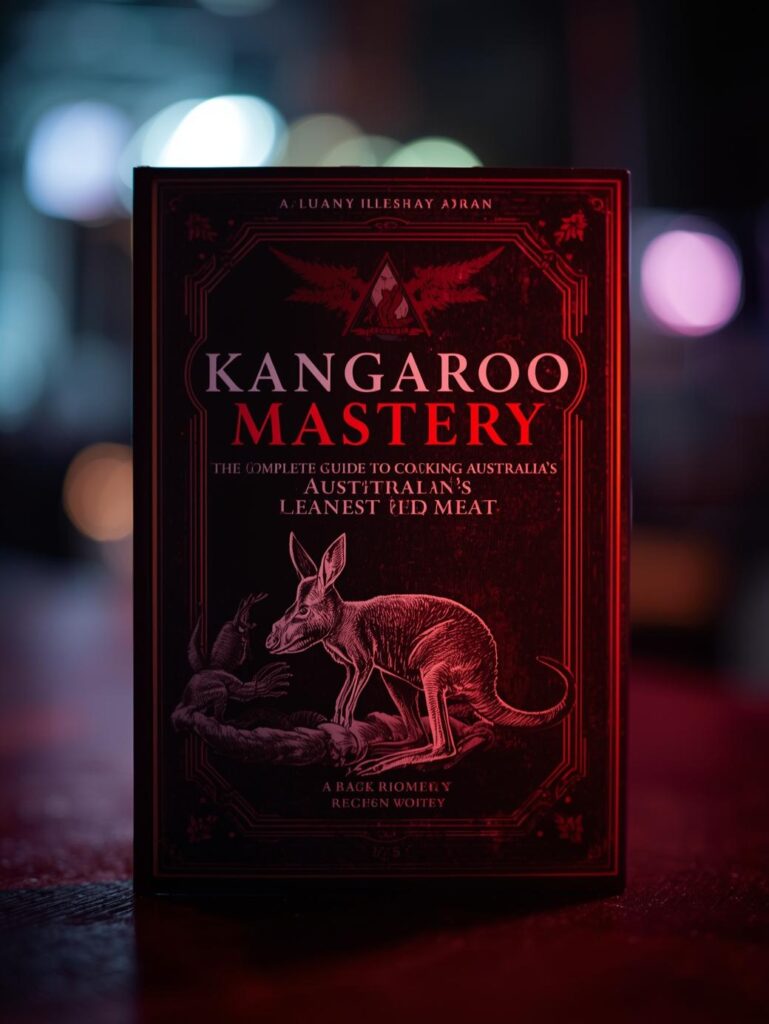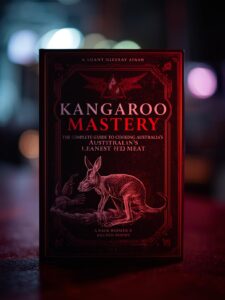The Ultimate Wild Protein: Kangaroo isn’t just another red meat—it’s the leanest, most sustainable protein you’ve never cooked. Where beef is marbled and familiar, kangaroo is wild, gamey, and demands respect. This is meat that has never been domesticated, carrying the untamed flavor of the Australian outback in every bite. Cooking it isn’t a substitution for steak; it’s an adventure into what red meat was always meant to be.
Kangaroo Mastery: The Complete Guide to Cooking Australia’s Leanest Red Meat
“Kangaroo is the marathon runner of the meat world—all lean muscle and intense flavor with virtually no fat to hide behind. Cooking it teaches you the most valuable lesson in meat mastery: when there’s no marbling to melt and baste, every degree of temperature matters. This isn’t meat you dominate; it’s meat you negotiate with. Respect its leanness, complement its gaminess, and cook it with precision, and you’ll discover a protein so clean and flavorful it will change your definition of red meat forever.”
Kangaroo Mastery: The Complete Guide to Cooking Australia’s Leanest Red Meat
Download Our Kangaroo Quick-Reference - Cuts, Cooking Times & Marinade Recipes
Kangaroo meat is Australia’s best-kept secret—a protein so lean it makes venison look indulgent, with a flavor profile that sits somewhere between beef and game. But most cooks approach it like any other red meat and end up with tough, dry results. The secret to kangaroo lies in understanding that its incredible leanness (98-99% fat-free) demands specific techniques and flavor partnerships. This guide will transform you from kangaroo novice to confident master of this unique, sustainable protein.
🎯 KANGAROO VS. BEEF: THE LEANEST SHOWDOWN
Understanding the dramatic differences is crucial to cooking success.
🦘 KANGAROO PROFILE
- Fat Content: 1-2% (extremely lean)
- Flavor: Gamey, rich, slightly sweet
- Texture: Dense, fine-grained
- Color: Very dark red, almost purple
- Cooking: Demands precision and moisture
🐄 BEEF PROFILE
- Fat Content: 15-30% (marbled)
- Flavor: Mild, buttery, familiar
- Texture: Tender, variable grain
- Color: Bright to dark red
- Cooking: Forgiving, versatile
🔪 THE KANGAROO BUTCHER’S GUIDE
Kangaroo cuts behave differently than beef—choose wisely.
🎯 Kangaroo Cut Masterclass
🎯 Matching Cuts to Cooking Methods
| Cut | Description | Best Cooking Method | Target Temp | Tenderness Level |
|---|---|---|---|---|
| Loin/Fillet | Most tender cut, minimal connective tissue | Grill, pan-sear (hot & fast) | Rare to Medium-Rare (120-130°F) | ⭐️⭐️⭐️⭐️⭐️ (Excellent) |
| Rump/Round | Lean, flavorful, slightly tougher | Roast, stir-fry, slice thin | Medium-Rare (130-135°F) | ⭐️⭐️⭐️⭐️ (Good) |
| Steaks | Various muscles, typically from hindquarter | Grill, pan-sear with marinade | Rare to Medium-Rare (125-135°F) | ⭐️⭐️⭐️ (Moderate) |
| Diced/Stew | Tougher cuts, perfect for slow cooking | Braise, stew, curry | Well-Done (160°F+) until tender | ⭐️⭐️ (Tough until slow-cooked) |
| Mince/Ground | Lean grind from trimming | Burgers, meatballs, bolognese | Well-Done (160°F) for safety | ⭐️⭐️⭐️ (Good when cooked properly) |
| Whole Leg | Large roasting cut, mixed tenderness | Slow roast, barbacoa-style | Varies by muscle (125-160°F) | ⭐️⭐️⭐️ (Variable) |
🌡️ THE TEMPERATURE CRISIS: RARE OR RUINED
With kangaroo, a few degrees make the difference between sublime and shoe leather.
⚡ The Kangaroo Doneness Spectrum
There is No Room for Error
- Blue Rare (115-120°F): Cool red center. For true adventurers only—intense flavor but very gamey.
- Rare (120-125°F): Warm red center. Maximum juiciness, best for premium cuts like loin.
- Medium-Rare (125-135°F): THE SWEET SPOT. Warm pink center. Balanced juiciness and flavor development.
- Medium (135-145°F): Light pink center. Beginning to dry out—only acceptable for tougher cuts.
- Medium-Well (145-155°F): Slightly pink. Significantly dry and tough.
- Well-Done (160°F+): Gray throughout. COMPLETE DISASTER for steaks. Reserve only for ground meat or slow-cooked dishes. Temperature guide here.
🔥 THE TWO KANGAROO COOKING PHILOSOPHIES
Choose your path based on the cut and your flavor goals.
⚡ HOT & FAST
For Premium Cuts (Loin, Fillet, Steaks)
- Goal: Sear quickly, preserve juices
- Method: Screaming hot grill or pan, 2-3 minutes per side
- Temperature: Rare to medium-rare ONLY
- Key: Bring to room temp first; don’t move while searing
- Result: Juicy, tender, game-forward flavor
🐢 LOW & SLOW
For Tough Cuts (Stew, Diced, Shank)
- Goal: Break down connective tissue
- Method: Braise, stew, slow roast with liquid
- Temperature: 160°F+ until fork-tender
- Key: Use acidic marinades or cooking liquids
- Result: Falling-apart tender, mellowed gaminess
🧪 THE FLAVOR BRIDGE: TAMING THE WILD
Kangaroo’s robust flavor demands strategic partnerships.
🎯 The Kangaroo Flavor Matrix
Building Bridges to Balance Gaminess
- Acidic Marinades: Red wine, balsamic vinegar, lemon juice, yogurt. The acid helps tenderize and cut through gaminess. Marinate 2-4 hours, not overnight.
- Sweet Counterpoints: Fig jam, port reduction, cherry sauce, honey. Sweetness balances the savory intensity.
- Earthy Companions: Mushrooms, roasted root vegetables, rosemary, thyme. These mirror the wild, earthy notes.
- Bold Spices: Juniper berries, black pepper, garlic, smoked paprika. Stand up to the strong flavor without overwhelming.
- Fat Addition: Since kangaroo has no fat, add it externally. Cook in duck fat, serve with compound butter, or wrap in bacon.
🍖 GRILLED KANGAROO LOIN: THE ULTIMATE SHOWCASE
When treated right, kangaroo loin is a lean, flavorful masterpiece.
👨🍳 Perfect Kangaroo Loin in 15 Minutes
Precision Cooking for Perfect Results
- Step 1: Marinate (Optional but Recommended): 2-4 hours in red wine, garlic, rosemary, and a touch of olive oil.
- Step 2: Temperature Acclimation: Remove from fridge 30 minutes before cooking. Pat completely dry.
- Step 3: High Heat Sear: Get grill or pan screaming hot. Brush loin with oil, not the cooking surface.
- Step 4: Cook 2-3 Minutes Per Side: For a 1.5-inch thick loin. Develop a deep brown crust.
- Step 5: Check Temperature Early: Start checking at 2 minutes per side. Pull at 125°F for medium-rare.
- Step 6: Rest Critically: Rest for 5-8 minutes. The temperature will rise to 130-135°F. Resting science here.
- Step 7: Slice Against the Grain: Notice the grain direction and slice perpendicular to it for maximum tenderness.
🚨 KANGAROO TROUBLESHOOTING: FIX COMMON MISTAKES
🎯 Kangaroo Cooking Rescue Guide
| Problem | Cause | Immediate Fix | Prevention |
|---|---|---|---|
| Tough & Chewy | Overcooked | Slice very thin against grain; use in salad or stir-fry | Use thermometer; pull at 125°F; never cook beyond medium |
| Extremely Gamey | Strong flavor, no balancing | Serve with sweet fruit sauce or bold pepper sauce | Marinate with acid; pair with sweet/savory elements |
| Dry & Grainy | Overcooked + no added fat | Dice and use in chili or curry with extra liquid | Cook to rare/medium-rare only; baste with butter |
| Lacks Flavor | Underseasoned, mild preparation | Serve with flavorful sauce or compound butter | Be generous with salt and spices; use marinades |
| Burnt Outside, Raw Inside | Heat too high, cut too thick | Finish in 400°F oven until target temp reached | Use two-zone cooking; reverse sear for thick cuts |
🌱 THE SUSTAINABILITY STORY
Kangaroo isn’t just delicious—it’s environmentally responsible.
🦘 Why Kangaroo is a Climate-Friendly Choice
- Low Methane Production: Kangaroos produce virtually no methane compared to cattle.
- Native Species: They’re adapted to the Australian environment and don’t damage fragile ecosystems.
- No Antibiotics or Hormones: Wild-harvested means completely natural, drug-free meat.
- Efficient Water Use: Require significantly less water than beef cattle.
- Population Management: Harvesting is government-regulated to maintain healthy populations.
🏁 THE WILD PROTEIN REVOLUTION
Kangaroo is more than just meat—it’s a statement. It’s a choice to explore beyond the familiar, to embrace leanness as a virtue, and to participate in a more sustainable food system. Cooking kangaroo will make you a better cook across the board, teaching you precision, the importance of temperature control, and how to build flavor bridges that transform challenging ingredients into spectacular meals.
Start with a simple kangaroo steak. Respect its need for rare doneness. Pair it with a bold pepper sauce or fruit reduction. You’ll discover a protein so clean and flavorful that it will reset your palate and expand your culinary horizons. The wild is calling—and it tastes incredible.
Deepen your expertise with our complete guide to cooking all game meats
No posts selected. Please provide either "slugs" or "ids" parameter.
Continue Your Game Meat Journey: Expand your wild protein expertise with these guides.



